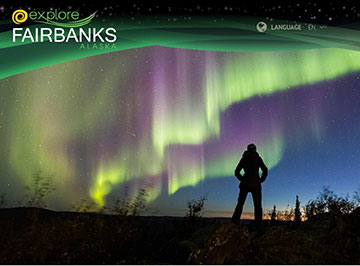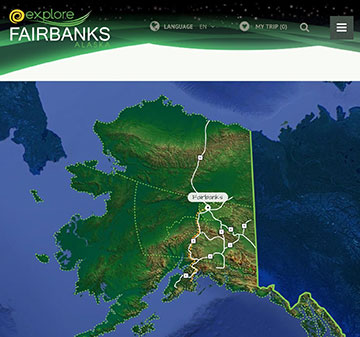Well we had hoped to do some nighttime observing at the OCA star party, but again the cloud forecast is not looking good.
 |
| Scope Nights screenshot shows poor observing weather not good for OCA Star Party? (Source: Palmia Observatory) |
Ok, if we can't observe here in sunny California, let's consider another attempt at seeing the northern lights and go up north to Alaska. It turns out that Fairbanks, Alaska, is a really good location to see the northern lights and the weather there can be more cooperative. This screenshot from the Explore Fairbanks website makes it look really exciting.
 |
| Anybody up for another search for aurora ? (Source: www.explorefairbanks.com) |
 |
| Aurora forecast model shows when oval is over Alaska (Source: www.swpc.noaa.gov) |
Ok, so what say everyone else out there? We are looking at planning a little flight up there and try our luck again at seeing the aurora.
 |
| Searching for aurora in Fairbanks, which is just 200 miles below Arctic Circle? (Source: www.explorefairbanks.com) |
Now Fairbanks is about 200 miles south of the Arctic Circle, but as we have seen it is well within the aurora oval. It's not clear if we should get rental car or not. It used to be that rental cars were not allowed on the highway for the drive from Fairbanks to the Arctic Circle. The road up that way, known as the Haul Road or the Dalton Highway, is gravel and is primarily for heavy truck traffic going along the Trans-Alaskan Pipeline up to Prudhoe Bay. But, we don't need to make our way up to the Arctic Circle because we had already received our certificate for a very convenient way of crossing the circle and that is by just laying around on our cruise ship as it crossed the circle.
 |
| Certificate from Viking Sky after sailing across the Arctic Circle |
The course covers the arctic weather and ecology and I've completed the lectures on permafrost, snow and glaciers. Professor Callagan ties in the geography with some of the native peoples in the area and the stories that they tell about surviving in the area. His illustration of the ocean currents that bring warm water up the coast of Norway and keep that area warmer than other areas of similar latitude was pretty interesting. So, the same ocean current that keeps the Norwegian coast warm then turns around and returns as cold water along the eastern coast of Canada and the US and makes them colder than would be expected based on latitude.
 |
| Professor Terry Callaghan explains ocean currents which warms Norwegian coast (Source: www.coursera.org) |
Professor Callaghan also described how the amount of global temperature increases affects different parts of the globe at different rates. In this screenshot we see that the arctic region is experiencing much higher rate of change in temperature. On average the global temperature is increasing, its just that some areas of the globe are seeing more of the temperature change and interestingly the further you are away from the equator the higher the rate of change.
 |
| Professor Terry Callaghan explains measured Arctic warming at twice global rate (Source: www.coursera.org) |
I am looking forward to the next few lectures, but in the meantime, we received a tweet from Professor Katherine Freese, who alerted us to a study, conducted by one of her former students, that measured the extent to which the universe is isotropic. Measurements with the cosmic microwave background, associated with redshifts in the neighborhood of 1100, have shown that at that early history of the universe, it was indeed very isotropic, i.e. it looks the same in all directions. Remember that when astronomers talk about isotropy, they mean isotropy on very large scales and not when we look out at say our local neighborhood of stars where we see solar systems and our own Milky Way. Only on much larger scales do this local features sort of fad into the background and no matter which direction you look do you see the universe looks the same in all directions.
This new measurement uses supernovae and extends it from previous studies that redshift z < 0.68 and added data from the Sloan Digital Sky Survey, which increased the sample size to 1048 objects, and looked farther back in time to redshift, z < 2.26. This new measurement which builds on and improves the statistics of the tests done in the past 9 years to shows the variation from purely isotropy is less than 1%. So, the universe started off as isotropic at say 13 billion years ago, as shown by the CMB, and stayed isotropic up to our current age.
 |
| Using supernova measurement of isotropic expansion (Source: Soltis, et al, arXiv:1902.07189v1) |
It is neat to see measurements of key astronomical parameters can be made to the 1% level. Now, I had a hard time going through the paper and understanding all of the statistical tools used in the analysis, but maybe you will have more luck. I determined that my homework necessary just to begin the statistical analysis was to go back and try to set up a model that starts with isotropic distribution of galaxies and then trying to calculate what the power spectrum of that distribution should be. Then you could go back and overlay the actual measurements and look at the residuals. That is sort of what the paper seemed to be doing, but I will have to postpone some of the homework. A chart from the paper shows the residuals, the difference between an purely isotropic model of the universe and the actual measurements is shown below. So the residuals are gaussian, which is a good sign, but in looking at how the data is projected on the map, it is not obvious to this set of student eyeballs, that the galaxy locations are isotropic. Hmm, got to work through this idea!
 |
| Using supernova measurement of isotropic expansion (Source: Soltis, et al, arXiv:1902.07189v1) |
Remember that it was not too long ago that the Hubble constant was only know to like a factor of 2. Now the Hubble constant is known at the couple of percent level and in fact the two key measurement techniques differ by just a couple of percent and this difference may now be used to find new physics as we move forward and determine which method is more accurate.
Until next time,
Resident Astronomer George
If you are interested in things astronomical or in astrophysics and cosmology
Check out other postings on this blog at www.palmiaobservatory.com

No comments:
Post a Comment